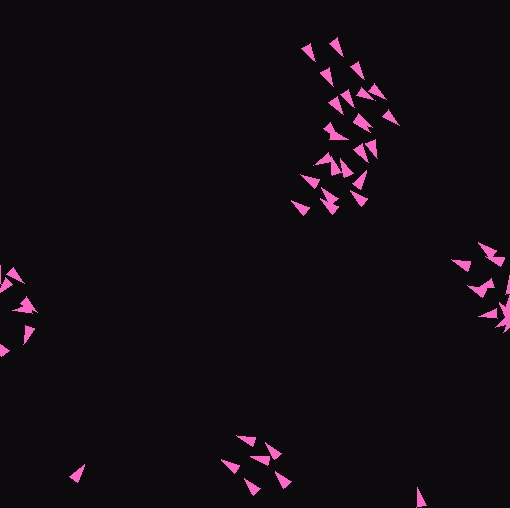Boids are used to simulate bird flocks, animal herds, and fish schools & is an example of swarm intelligence. Swarm intelligence refers to the collective behavior of individual agents who interact locally with one another and their environment to produce global patterns or behaviors. Individual members exhibit simple behaviors, but together they create complex movements or patterns that benefit the group as a whole, such as predator evasion, foraging efficiency, or navigation.
In my birds game, I did not use swarm behavior in birds motion, which resulted in unrealistic birds behavior. Using models such as boids, bird flocks could have been simulated much better.
Modelling Boids
Flocking behavior can be modelled with some basic rules (paper):
- Separation: Each boid tries to maintain a minimum distance from other nearby boids to avoid collisions. It moves away from other boids that are too close. This avoids clumping.
- Alignment: Each boid adjusts its velocity to match that of its neighbors. It tries to align its direction with the average direction of nearby boids.
- Cohesion: Each boid moves towards the average position of its neighbors. It tries to stay close to other boids, thus maintaining the cohesion of the flock.
Improvements
The above mentioned algorithm is very basic. To improve it, we can take into account things such as collision avoidance with objects, path finding (towards food sources or bird migrations) & so on. All of it depends on the kind of game in which it is being implemented.
Boids Implementation Python
import pygame
import random
import math
# Constants
WIDTH, HEIGHT = 512, 512
NUM_FISH = 50
MAX_SPEED = 2
NEIGHBOR_RADIUS = 50
SEPARATION_RADIUS = 30
SEPARATION_FORCE = 0.8
ALIGNMENT_FORCE = 0.1
COHESION_FORCE = 0.05
SCREEN_CENTER = (WIDTH // 2, HEIGHT // 2)
BG_COLOR = (15, 10, 15)
FISH_COLOR = (255, 100, 200)
class Fish:
def __init__(self, x, y, vx, vy):
self.x = x
self.y = y
self.vx = vx
self.vy = vy
def update(self, flock):
# Rule 1: Separation
separation = self.separate(flock)
# Rule 2: Alignment
alignment = self.align(flock)
# Rule 3: Cohesion
cohesion = self.cohere(flock)
# Update velocity
self.vx += separation[0] * SEPARATION_FORCE + alignment[0] * ALIGNMENT_FORCE + cohesion[0] * COHESION_FORCE
self.vy += separation[1] * SEPARATION_FORCE + alignment[1] * ALIGNMENT_FORCE + cohesion[1] * COHESION_FORCE
# Limit speed
speed = math.sqrt(self.vx ** 2 + self.vy ** 2)
if speed > MAX_SPEED:
scale_factor = MAX_SPEED / speed
self.vx *= scale_factor
self.vy *= scale_factor
# Update position
self.x += self.vx
self.y += self.vy
# Wrap around screen
if self.x < 0:
self.x = WIDTH
elif self.x > WIDTH:
self.x = 0
if self.y < 0:
self.y = HEIGHT
elif self.y > HEIGHT:
self.y = 0
def separate(self, flock):
separation_vector = [0, 0]
for other_fish in flock:
if other_fish != self:
distance = math.sqrt((self.x - other_fish.x) ** 2 + (self.y - other_fish.y) ** 2)
if distance == 0: # To avoid division by zero
distance = 0.001
if distance < SEPARATION_RADIUS:
separation_vector[0] += (self.x - other_fish.x) / distance
separation_vector[1] += (self.y - other_fish.y) / distance
return separation_vector
def align(self, flock):
avg_velocity = [0, 0]
num_neighbors = 0
for other_fish in flock:
if other_fish != self:
distance = math.sqrt((self.x - other_fish.x) ** 2 + (self.y - other_fish.y) ** 2)
if distance < NEIGHBOR_RADIUS:
avg_velocity[0] += other_fish.vx
avg_velocity[1] += other_fish.vy
num_neighbors += 1
if num_neighbors > 0:
avg_velocity[0] /= num_neighbors
avg_velocity[1] /= num_neighbors
return avg_velocity
def cohere(self, flock):
center_of_mass = [0, 0]
num_neighbors = 0
for other_fish in flock:
if other_fish != self:
distance = math.sqrt((self.x - other_fish.x) ** 2 + (self.y - other_fish.y) ** 2)
if distance < NEIGHBOR_RADIUS:
center_of_mass[0] += other_fish.x
center_of_mass[1] += other_fish.y
num_neighbors += 1
if num_neighbors > 0:
center_of_mass[0] /= num_neighbors
center_of_mass[1] /= num_neighbors
return [center_of_mass[0] - self.x, center_of_mass[1] - self.y]
else:
return [0, 0]
def draw(self, screen):
# Draw fish as an arrow shape
angle = math.atan2(self.vy, self.vx)
pygame.draw.polygon(screen, FISH_COLOR, [(self.x + math.cos(angle) * 10, self.y + math.sin(angle) * 10),
(self.x + math.cos(angle + 5 * math.pi / 6) * 10, self.y + math.sin(angle + 5 * math.pi / 6) * 10),
(self.x + math.cos(angle - 5 * math.pi / 6) * 10, self.y + math.sin(angle - 5 * math.pi / 6) * 10)])
def main():
pygame.init()
screen = pygame.display.set_mode((WIDTH, HEIGHT))
pygame.display.set_caption("Boids Simulation")
clock = pygame.time.Clock()
# Create fish
fish = [Fish(random.randint(0, WIDTH), random.randint(0, HEIGHT), random.uniform(-1, 1), random.uniform(-1, 1))
for _ in range(NUM_FISH)]
# Main loop
running = True
while running:
for event in pygame.event.get():
if event.type == pygame.QUIT:
running = False
# Update fish
for fishy in fish:
fishy.update(fish)
# Draw
screen.fill(BG_COLOR)
for fishy in fish:
fishy.draw(screen)
pygame.display.flip()
clock.tick(60)
pygame.quit()
if __name__ == "__main__":
main()
More Links
- There are some optimization algorithms based on how ants, bees or other species interact to find shortest distances (or lower-cost solutions to a problem). These algorithms are ant colony optimization for example.
- External links for boids: https://cs.stanford.edu/people/eroberts/courses/soco/projects/2008-09/modeling-natural-systems/boids.html
- Boids by Craig Reynolds: https://www.red3d.com/cwr/boids/

